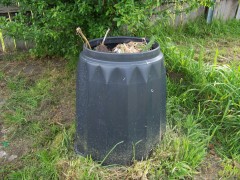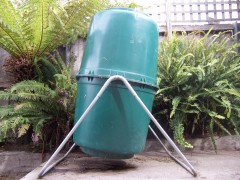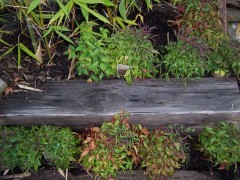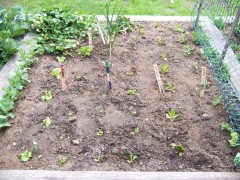You can bury a lot of troubles digging in the dirt.
~Author unknown
Soil treatment is a very important aspect of organic gardening. There are many healthy and organic methods to insure the nutritive value and well-being of our garden's soil.
Many commercial farmers use chemical fertilisers and pesticides to aid in growing their crops. While these methods may provide short term benefits to the cultivation of plants they also have detrimental effects. An over-reliance on chemical fertilisers and a failure to re-introduce natural organic elements to the soil will eventually deplete vital elements over a period of time, resulting in soil that is completely dependent on the use of these fertilisers in order to grow crops. As organic gardeners it is our job to provide natural nutrients to the soil without resorting to these chemical methods.
Our soil's health is increased and maintained primarily through three methods: composting, mulching, and crop rotation.
Composting
Composting is the decomposition of organic matter. The resulting nutrient-rich compost can be used in the garden as a mulch or worked into the soil to provide vital elements to the surrounding plant life.

A compost bin resting on the ground also
fertilises the earth on which it stands.
Photographed by Brendan Gasparin.
Almost anything organic may be composted: lawn clippings, cardboard, paper, table scraps, and the manure of herbivores and birds. Dairy products, meat, and the droppings of omnivores and carnivores should be avoided as these can stink, attract pests, and even spread disease.
A compost heap can be contained in many ways. You may simply pile compost in the open, but more attractive and less offensive alternatives include containers constructed from wood and/or wire mesh, or commercial compost bins sold on the market. Many of these include features that increase aeration of the compost, such as tumbler bins. This is highly desirable as aeration is an important factor toward creating good compost.
In composting, the organic matter is broken down by aerobic bacteria which convert the material into nitrites and nitrates which can be used as nutrients by growing plant-life. Because of this, it is important that the compost heap has a ready supply of oxygen to allow for this aerobic decomposition. While neighbours may complain about an open compost heap, the alternative (wherein the compost heap is sealed and not allowed oxygen) will result in anaerobic decomposition, which produces methane and carbon dioxide as by-products and smells far worse than a healthy oxygenated compost heap. For this reason it is also important to turn compost regularly, to allow the oxygen to access as much of it as possible.

A tumbling compost bin provides excellent
aeration for all the compost it contains.
Photographed by Brendan Gasparin.
Good compost requires four components: carbon, nitrogen, oxygen, and water. Materials with a lot of carbon tend to be brown and dry (such as branches), while materials high in nitrogen tend to be green and wet (such as grass clippings). Fruit and vegetables also supply plenty of nitrogen. The ideal ratio of carbon to nitrogen for composting is 30 parts carbon to 1 part nitrogen. Of course, most compostable materials will contain both of these elements in some ratio, so a lot of guess-work would be involved in obtaining the perfect mix. For home gardening purposes it is perfectly acceptable to just compost everything you can get your hands on and hope for the best results.
Heat is also an important factor in allowing compost to break down as quickly as possible. In fact, the bacterial activity in compost creates quite a bit of heat in and of itself (and particularly large compost heaps, such as those found on farms, have even been known to burst into flames. Because of this, it is best to position your compost heap somewhere where it will receive as much natural sunlight as possible. You may also wish to keep your compost heap in an out of the way place, as it will create some odour, and may attract fruit flies after being fed fruit and vegetables.
Compost requires activation in order to set off the decomposition process. This is as simple as adding a compost activator to the mixture. Ideal compost activators include herbivore manure, bird manure, and the herb comfrey.
Mulching

Plants bedded in an organic mulch.
Photographed by Brendan Gasparin.
Mulching is another important part of organic gardening. This is the process of laying down some sort of cover on the soil. By mulching, we reduce soil erosion, allow the soil to retain moisture and heat more easily, and supress the growth of weeds. Organic mulches also act as a fertiliser, lending nutrients to the earth as they gradually decompose, and the use of compost as a mulch is even known to control and deter pest populations.
Mulch may consist of many different things: compost, pine bark, wood chips, and newspaper all make good mulch. It is even possible to use inorganic matter such as pebbles or blue metal as mulch. The main benefit of using inorganic material as a mulch is that it will not decompose, and will therefore require replacement less frequently. But as previously mentioned, organic material will lend nutrients to the soil as it decomposes. The gardener must therefore decide on a case-by-case basis what is the best material to use for mulch in a given area.
Many plants benefit from mulching, but we must be careful to mulch around the plant and not right up to the base. Some organic mulches can cause rot in the stem of a plant if placed too closely.
Crop Rotation

Never plant the same crop in the same bed
for two seasons in a row.
Photographed by Brendan Gasparin.
Every plant we grow depletes certain nutrients from the soil. Many will also attract certain types of insects and pests. The commercial farmer may patch this problem through the use of chemical fertilisers and pesticides. As organic gardeners we refuse this option and instead solve the problem of nutrient depletion and pest accumulation with crop rotation.
Crop rotation means that we never plant the same vegetable in the same place in consecutive seasons. For example, if we plant tomatoes in one bed in a given year, then the following year we must plant our tomatoes in a different garden bed. This prevents the crop from leaching too much of a given nutrient from the soil, and also prevents the build-up of any pests or diseases to which that plant is prone.
For example, many heavy-feeding plants such as tomatoes and brassicas deplete the levels of nitrogen in the soil, whereas bean and pea crops are known to fix the levels of nitrogen in the soil. A good practice is to follow heavy-feeding crops with beans or peas, and then follow the beans and peas with root crops. In any event, the gardener should allow a period three or four years before planting the same vegetable in the same bed to prevent disease and infestation by parasites and other pests.
